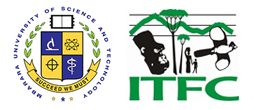Kabiranyuma swamp is one of the rarest afromontane swamp habitats in Uganda. The swamp is a major source of water for the Kabiranyuma Gravity Water Scheme that supplies water to over 21,000 people around Mgahinga Gorilla National Park. The Institute of Tropical forest Conservation-Ecological Monitoring Programme together with the Development Through Conservation of CARE are monitoring the impact of the water scheme on the ecology of the swamp and sustainability of water extraction from the swamp respectively.
Monitoring methods used are vegetation cover monitoring, fauna monitoring and hydrological monitoring. The vegetation cover monitoring was established by putting up a series of Permanent Sample Plots in the swamp to monitor changes in swamp vegetation over time and taking fixed-point photographs from the summit of Mt Gahinga for monitoring changes in swamp area cover. The fauna monitoring was established by carrying out a small mammal inventory within the swamp although successive inventories has not been possible due to insecurity in the park. Hydrological monitoring was established by CARE-DTC putting up a network of hydrological instruments to measure changes in water flows, water depth and rainfall.
A probable negative impact of the water scheme on the plant ecology was manifested in a slight increase in Hypericum revolutum seedlings in the swamp. This is an indication that the typical “dryland” plant species may be invading the central swamp area, as is also seen in the fixed-point photographs. The major swamp vegetation is Carex spp that constitutes over 50% vegetation cover and has been constant over a three-year study period (1999-2001). There is a decline in the number of the endemic Alchemilla johnstonii and Lobelia wollastonii plant species in the swamp, probably as a result of swamp drainage.
Successive fauna inventories within the park have not been possible due to the insecurity in Mgahinga. However work carried out by Kerbis and Austin in 1997 shows that there was no evidence of any endemic Albertine rift rodent species like the Delanymys brooksi in the channels that drain the swamp, and yet these occurred in the upper swamp and adjoining sedges. This implies that there is a decline in the number of the sensitive endemic species due swamp drainage by the water scheme.
Hydrological monitoring data is still being analysed by CARE-DTC. However work done my Mulders (1998) indicates that there is a close relationship between rainfall and water flows in the channels, implying that water extraction during the dry season will have the most negative impact on the swamp ecology.
A major constraint to the monitoring has been insecurity within the park that precludes sampling of nocturnal animals (amphibians and rodents) and fixed points photography from the top of Mt Gahinga. It is hoped that with the improvement of the security situation in Mgahinga Gorilla National Park, more monitoring work will be done that will provide useful information on the impact of the Kabiranyuma Gravity Water scheme on the ecology of the swamp.
Report File
- DocumentKabiranyuma swamp report 2003.pdf (1.42 MB)
